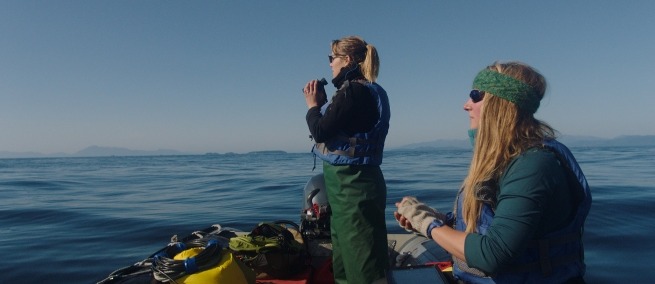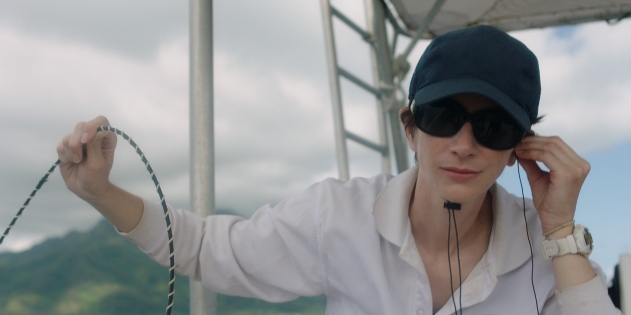
In Drew Xanthopoulos’s FATHOM, two scientists set out to sea on separate expeditions to study the sonic language and culture of humpback whales. Xanthopoulos’s film steers clear of easy answers and NatGeo-style spectacle to portray the women’s incremental work and capture the ethereal beauty of whale song. Filming solo and logging upwards of 150 shooting days—70 in the field in French Polynesia and southeast Alaska—Xanthopoulos plumbs new depths in our conception of culture and shows the human dimensions to science in practice. I spoke with the director in advance of his film’s premiere in the Tribeca Film Festival and its release on Apple TV+. FATHOM opens in theaters and is available on Apple TV+ on June 25.
Nicolas Rapold: Your film documents the day-to-day reality of scientists at work—the pedestrian setbacks as well as the brainstorming. Why did you choose this approach?
Drew Xanthopoulos: It’s my personal style: I enjoy the process. I consider myself a verité documentary filmmaker. I try to be a silent witness to what’s happening in their lives. I wasn’t expecting any breakthroughs in the field—you’d have to be a crazy person to expect any breakthroughs to happen in a single field season. But I thought the actual process of doing the work would be inherently dramatic, because even if you don’t answer your question at the end of it, you’re probably going to have new questions you didn’t know you’d ask. So you’re learning something. Science requires enormous patience. I wanted to do justice to what it is to be a field researcher, which is not just putting hydrophones in the water and crunching the numbers later. It’s fixing engines, feeding people, making sure no one’s going to die. It’s a lot.
NR: How did you connect with the two main scientists, Ellen Garland and Michelle Fournet?
DX: I had some parameters for the kind of scientists I was interested in for the film. One was that I wanted to meet a researcher who spent a lot of time out in the field at sea doing their work. That kind of immersion was really important to the film. A lot of people do amazing work from their lab with their computers, and I wanted someone who had to leave home and leave everything behind to immerse themselves in this other world. If that boat capsizes, they’re done for. To me, they’re like astronauts zipping off to this other world in their ship, trying to study this incredibly elusive intelligence. And to be honest, that’s a dying breed of scientist. It’s very hard to get funding for that kind of work.
I met Michelle first, through a mutual friend. She invited me to come out. I met Ellen afterward. They’re similar ages, so they had a lot in common, but also their work was so complementary. Michelle is trying to figure out the purpose of one sound that all humpback whales make everywhere, which happens to be the keystone sound to the relationships that they can maintain throughout their entire lives—which can be a century long! Ellen was looking at how their songs, how their culture, is shared across ocean basins. So she’s looking at the breadth of how far and wide they can connect using sonic culture, and Michelle is looking at the atoms of their relationships.

Dr. Ellen Garland in FATHOM, courtesy of Apple TV+.
NR: It’s always fascinating to me how science documentaries convey complicated ideas. About halfway through the movie, Ellen elaborates on how the whale sounds constitute a culture. Why not put that explanation earlier?
DX: I think the audience for this film is everybody. And the idea of the word “culture” existing in a sentence that doesn’t have the word “human” in it is—I think—new and nuanced for a lot of viewers. We wanted to build up to it as an idea that is in itself very subversive and profound. We do say at the top of the movie that the oldest cultures are not human, they’re from the ocean. The idea is planted there.
Ellen did not go out looking for culture when she was looking at how songs are shared across ocean basins, because she’s a great scientist: she was not looking for that [preconceived] conclusion. It was the only thing that could answer the question of what the hell was going on here.
NR: How would you define culture?
DX: [Pauses] I’m trying to remember all the things I read about how marine biologists very carefully define culture... There are two ways you can define culture. It can be very narrow, and you can basically come up with a list of things that only we do, which I think scientists have done for a really long time. The study of cultures and other animals is mostly about trying to prove how unique and special we are. But I think this new generation of scientists have taken a broader view on what culture is, and I think it’s actually more constructive. Fundamentally culture is the passing on of knowledge within a generation, so it couldn’t be genetic. Things that are learned from one individual to another within a generation are passed on sequentially. That can be how to get food, or it can be song [like the whales’]—whose purpose is actually still not known!
We know the whale’s songs probably have something to do with mating. But you could say the Beatles made their songs for reproductive purposes. And I think most people would agree that you couldn’t reduce it to just that. There’s something similar going on with humpback song.

Dr. Michelle Fournet in FATHOM, courtesy of Apple TV+.
NR: I came to understand their songs as partly how whale communities mesh together across great distances.
DX: One of our advisers gave a really interesting answer to me about why this is important. He said, if all of the humpbacks died, all of them went extinct, and we Jurassic Parked ten of them, 100 of them, a million of them back, and plopped them back in the ocean, not a single one would survive. Because you can bring back the genetics but the culture is lost, the knowledge is gone. And guess what other species you could say that for? Humans. If we just reset, and Martians or someone made lab humans and planted us back on the earth, we’d be the lowest-hanging fruit on the planet without our knowledge, without our culture. We are fundamentally a cultural species, and without it, we couldn’t survive. Whales are exactly the same way.
NR: What were the challenges in recording and presenting the whale sounds?
DX: This is fundamentally an acoustic movie, but it is because the scientists are acousticians. Whales primarily perceive themselves in acoustic space. We think that is the primary way they interact with their environment, because light isn’t present all the time and most of time it’s not that helpful. Michelle studies the individual sounds they make and the call that she is most interested in is the “whup” call. The calls have functions to them, and there’s not a one-to-one correlation to our words either. No one thinks that there’s a sound whales make that represents “fish.” It’s probably that those sounds represent a larger idea of what’s happening. It’s probably fairly complicated. So it’s probably not like what we do—it’s different. The scientists have internalized the sounds so much that Michelle, for example, as she’s listening to them, she’ll just start tracing shapes of the sounds in the air.
I was super lucky in that I have two of the greatest living acousticians in the world, who have collected some of the best recordings in human history of whale sounds. The sound designer and the sound mixer had a field day working with this stuff. It was some of the most beautiful, haunting, strange, and sometimes funny sounds that you could ever imagine! At one point we were working on an animation in the movie—and it was all temp stuff—and our animator said: I don’t want to give you notes on the sounds, but I just feel that this one sound effect you guys are putting in there just sounds a little cheesy. We said, what sound effect are you talking about? And it was one of the actual sounds that whales make! He thought it was something from STAR WARS, like a light saber sound.
NR: Could you talk about including the scientists’ discussions about their daily lives and life plans? For example, Michelle explains to a friend how she’d like to raise a child.
DX: There’s a truth to being a young female researcher that we wanted to do justice to. We never sought to cast women. We were looking for great scientists asking great questions and doing their work really well. When it became true that both of our scientists were women, it put that much more gravitas on the story we were telling. So we felt it important to include that discussion Michelle is having with her assistant, Natalie. It’s not a gendered issue. It’s about how you go and do this work that requires you to leave home for long periods of time while also—god forbid—having a life, having a family if that’s what you want, having a spouse if that’s what you want. I wanted to paint the full picture of these researchers as not just scientist who are doing the numbers and stuff, but as human beings with emotions and personal lives, and to show what it takes, and what kind of sacrifice it takes, to do their work.
NR: What did Michelle and Ellen think of your portrayal?
DX: They were collaborating with me on the narration [which they deliver], helping write it and get it right. But what I heard from both of them was a gratitude of capturing what field seasons are like. They’re whale scientists, and they get approached by filmmakers all the time. So, they’re used to people hopping on the boat and shooting over their shoulder at the whale. But when a whale breaches, I’m looking at Ellen and Michelle’s faces, because to me their reaction is what the audience will respond to. It took a long time to sink in that, no, you guys, I’m actually interested in you!
NR: Among your other nonfiction work about the world around us, you shot footage for Terrence Malick: VOYAGE OF TIME , his epic IMAX documentary. What exactly did you shoot?
DX: You know the primitive-looking footage that’s very grainy, very stylized? There are a few sequences in the film that are from rural Bulgaria during these very old, pre-Christian ceremonies. You’ll see people dressed up in these furry costumes from the hides of different animals and with these torches. I was in Bulgaria and they called me up and said they’d like me to take a camera over and if anything interesting is happening, to shoot it. And it made [it into] the film. I was pretty happy about that.
NR: What’s your next project?
DX: I’m in that nascent phase where I’m not sure if I’m reading for pleasure or reading for research. Which is a good space to be in—that’s how FATHOM started. It’ll be a branch off the same tree that FATHOM came off of.
♦
FATHOM is directed and filmed by Drew Xanthopoulos, and produced by Megan Gilbride. It made its world premiere at the Tribeca Film Festival and premieres globally on Apple TV+ on June 25, also opening in select theaters in New York and Los Angeles.
TOPICS